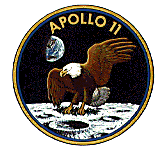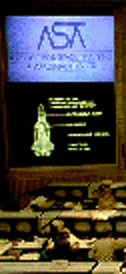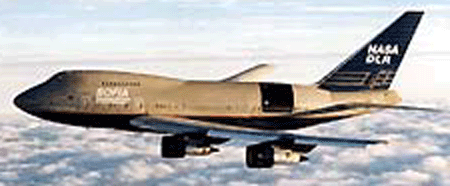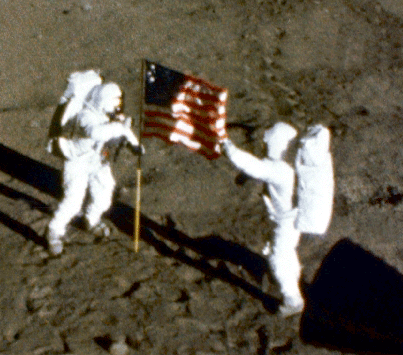THE RED, WHITE, AND
BLUE...
Many skeptics of the success of Apollo 11
claim the "waving flag" as ground for believing that the Apollo
mission was faked. In many pictures taken during the Apollo 11
mission the flag planted on the moon seems to be waving, as if it
were being blown about by wind.
There is no better way to depict a success
of a nation than by firmly planting its' flag in the ground and
claiming a victory for all of mankind. It makes perfect sense then
for Neil Armstrong to have planted the flag on the moon after
stepping on its Dusty surface. In fact, this ritual is performed by
all nations. They too proudly bear their nations emblems on the body
of space shuttles, satellites and the like, and as long as they are
successful, their government is happy to pick up the bill. The
purpose of these emblems is publicity. The goal of these agencies is
to keep people interested, as well as to spread knowledge. Unless
these agencies make their presence known in a fashionable manner this
goal cannot be accomplished.



The first image is the official emblem of
the Apollo 11 mission. In the second image, the Russian space program
emblem is visible in the control room of the agency. The third image
is of the SOFIA infrared telescope, a joint project between NASA and
the DLR of Germany.
The flag does in fact appear to be waving
in the still picture below; there is no contesting that point.
Skeptics automatically assume that this is sound proof that the flag
was being planted on Earth and not the Moon. However, there is one
aspect of this photograph that is important to note. Both Armstrong
and Aldrin are touching the flag in the process of planting it into
the moons surface (which, as I have previously stated, is covered in
a layer of dust). Skeptics have ignored two important facts in this
instance, but we will return to those in a moment.

Most would agree that NASAs' scientists are
among the most brilliant people in the world. It is, therefore,
natural to ask why anyone would assume that these men (and women,
today) would be so ignorant as to ignore the fact that a flag would
flutter being planted on Earth (on a windy day that is), but would
not when being planted on the Moon because it has no
atmosphere?
There is a simple answer to this question;
they would not. NASA's scientists are, and were, aware that there is
no atmosphere on the moon. As such, they were more than prepared for
this fact when they sent a flag with Apollo 11 and made sure that the
flag would be constructed in such as way that would allow onlookers
to see all of the stars and stripes. On the Earth, flags are usually
hung from a pole or rod. On the Moon the flag was hung in the same
fashion, but with a second rod protruding parallel with the Moons
surface from the first rod. It is from this rod that the flag hung,
forcing it to stick straight out and be visible. For appearance
purposes this rod was slightly shorter than the flag itself, giving
it that rippled effect (that is, after all, how we are all use to
viewing the flag). Furthermore, when NASAs' scientists sent Apollo 11
to the moon, they had public policy in mind. When it comes to viewing
the flag on the moon, which would make for a better presentation: a
limp, dreary flag, or a flag standing proud in its nation's namesake?
I think the response is obvious. The fact is the U.S. flag appears to
have ripples in it in photographs on the moon because NASAs'
scientist intended it to.
To better present how such a design would
make a flag appear, I constructed two flags and took video footage of
the flags in two settings. One flag was constructed as NASA
constructed the flag planted on the moon; the other was constructed
as flags typically are for display on earth. In one situation, the
flags are presented outdoors so that you may observe how flags
constructed differently behave in a windy environment. This clip
shows you exactly how the flags appear when waving. Notice that the
flag constructed as NASA did does not ripple exactly the same every
time it is blown, notice also that the bottom tale of the flag (the
one not connect to the pole) flips when it is blown, it does not
stand still as the rest of the flag waves as the flag in Apollo 11
pictures did.
The second clip is of the flags in an
indoor setting. We are unable to simulate the exact conditions of the
moon because we lack the equipment to create a room with no
atmosphere. However, this clip shows you how the flags behave in a
windless environment. Notice that the flag constructed as NASA did
has ripples in it just as the flag on the moon does. Notice also that
those ripples do not change, again just as the ripples on the flag on
the moon do not change. The gentleman in the background is present to
demonstrate that there is actually motion in the video.
Returning to the fourth picture on this
page, we see that the flag "ripples" and that Armstrong and Aldrin
are planting the flag into the Moons terrain. What skeptics have
ignored in this instance is that 1) Armstrong and Aldrin are, in
fact, touching the flag, and 2) that the Moon's terrain is mostly
dust. The "waving" of the flag is very easy to explain. To plant the
flag Armstrong had to twist it back and forth in order to get it to
stand in the moons soft surface. It was this movement that makes the
flag appear to be "waving," not the wind.
Visit the links below and review the pictures
found.
Careful observation of the Apollo 11 flag
in these pictures reveals that not only can you easily see the bar
which sun. For example, near the edges of the flag not supported by a
pole, the flag "flutters" one direction and then back the opposite
direction. This type of uniformity could not be accomplished if the
flag were fluttering due to a breeze.
The diagram below depicts where each flag
was located. The flag in the center represents the idea that the flag
is facing the Lander. The small circle is the Lander itself, and the
large circle represents the Landers' field of view from the front of
the craft. Photographs one, two, and three are all taken at the same
angle. Photograph four is taken at the opposite angle.

NASA has made mpeg videos from clips of the
original films from the moon. Two clips are of particular interest,
as they show the
flag being deployed (2.8Mb) and
the
flag not waving (1.4 Mb) as
astronauts collect lunar samples nearby. As you can tell from the
shadows on the lunar surface, the camera was mounted on the side of
the LEM (to access additional videos, visit http://spaceflight.nasa.gov/gallery/)
As you watch these videos, it is interesting to note that the flag
only moves when the astronauts are touching it, and moves
considerably when they are forcing it into the Moon's terrain. As the
astronauts work, watch the shadow created by the flag for a more
precise idea of exactly how, and more importantly when, it moves.
Links with This Information:






